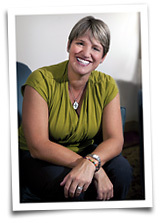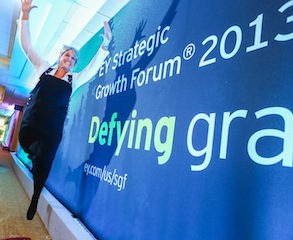Part Two: Demystifying management consulting with a leading entrepreneur in the field
The Winning Women honorees
Nine years after being honored myself, I was back at the EY Strategic Growth Forum.
Entrepreneurial rock stars backstage: Chobani founder Hamdi Ulukaya; Josh, a NFTE grad; EY's Chairman and CEO Mark Weinberger; and Alida Boer.
The most powerful event, and also my favorite, was the luncheon honoring top women entrepreneurs. I was excited to be there since NFTE is represented by incredible leading women -- including Maria Pinelli, EY Global Vice Chair of Strategic Growth Markets and NFTE board member; and our president and CEO, Amy Rosen.
Amy Rosen.
I love movies, so I was thrilled when I saw that EY had arranged for Sally Field to speak to us. Little did I know that Sally was so well acquainted with entrepreneurship. She spoke about what it feels like to be an entrepreneur, to have that "gnawing" feeling, "like squirrels chewing on your feet," as you passionately work towards your goal, refusing to follow the rules you're supposed to follow. She told us about what it takes to be a successful actor, to have a 50-year career like her own: the very same "gnawing" that makes a great entrepreneur.
Sally on stage.
After meeting Dr. Lisa Williams at EY's incredible event that honors our country's top women entrepreneurs, I got to meet with Joy Taylor of TayganPoint Consulting Group (http://tayganpoint.com/).
Joy's story fascinated me. She is a fourth-generation ferryboat operator, lived in New Zealand, worked in statistical process improvement at General Electric, transitioned to PriceWaterhouseCoopers, and then started her own company in 2005. She calls her business a process management firm (also known as management consulting). Joy owns 51 percent of the company, which has grown to approximately 70 employees, 70 percent of whom are women, all of whom are seasoned, senior consultants.
Taygan Point Consulting now generates more than $14 million annually in revenue, competing with McKinsey and Deloitte. Its competitive advantage is to focus on quality, not quantity. Joy told me: "All of our consultants are well-experienced in the field. We don't have junior members. Our process is different in that we don't have a huge team; we choose a select group of seasoned experts who consult with the client anywhere from one to five days of the week."
As all great companies, TayganPoint Consulting Group developed into the powerhouse is by perfecting one key service. Consider them the masters of process. During our time together, Joy defined this term for me, and shared some of her insight in the area.
Joy Taylor.
Steve Mariotti: Can you explain the terminology? Is it management consultant?
Joy Taylor: I describe myself as a process expert in the world of process management, process improvement, organizational effectiveness.
Everyone has a process. Imagine that in large companies, where they have a budget process. They send out strategic direction on what the company's going to do in the next three to five years. They send that guidance out to all the department heads saying we want to grow by so much, we want to reduce costs by so much, we want to focus on these geographic regions, what ever the strategic direction of the company's going to be. Then each department head decides how that is going to affect each group.
Well, suppose you have an organization that needs to control costs and they are seeking to either increase their business, but they don't want to hire more full-time individuals, so they need to be more efficient in their transactions, we will study the process.
How does marketing need to spend money in 2014 if I'm going to expand into the Asian-Pacific area or the South American markets. And they start thinking about how they're going to spend money, utilize individuals, whether they need to increase headcount, decrease headcount, and then they put in numbers -- they say I'm going to spend this much money, I'm going to put in these kinds of programs, want to spend money on this much media, this much branding, this much headcount, and then they submit those numbers, and then somebody reviews those numbers, they then send those numbers back after they've approved or not approved -to the department head. And then the department head has to determine whether they can fulfill the strategic vision of the company with the amount of money that's been approved for them to spend.
And that makes it sound so simple -- except that a company like Merck or J&J or -- a media organization. A department head may say, "I need $100,000 to accomplish this goal, to meet the strategic direction, but they only get approved for $70,000." So what do you cut? Do you cut a project? Do you cut a person? Do you half-ass something else? Do you ask for forgiveness and spend $110?
But the budgeting process is what gives companies a metric whether they are successful or not.
Joy sharing her knowledge with me.
SM: What is productivity? What's the numerator and denominator?
JT: The most efficient and effective way for a transaction to be completed. This all depends on the industry. It could be labor, it could be time.
It's usually labor and revenue. Organizations might do cost per unit, or cost per employee. Transactions per employee. Those are some metrics that have been used.
As Deming would state, "If you don't measure it, you can't fix it. And you can't manage it."
SM: Can you explain the importance of defining a process?
JT: You and I need to share the same definition of what it means to turn the car on. Is the car just in neutral--like you can hear the radio? Or is it that the engine is fully going?
Joy at the EY event!
SM: How important is documentation?
JT: Massive. Especially if you're working in an organization with high-transaction, high-turnover call centers. You hire thirty people to answer telephone calls. If a customer calls, all thirty of these employees should know how to exactly access an account without question or hesitation.
You cannot replicate, you cannot improve, you cannot measure for success. The idea is that documentation helps eliminate waste, reduces cycle time to get things accomplished. And the more repetition, the more efficient and effective people can be. And then you train from that.
If nobody reads the process, you are lost. What about the exception?A client calls: "I want access to my account, and now I want to complain about something." And they say, "well, I don't know the information. I'm going to have to send that to my manager."
Well, what about if all thirty of the members of my call center escalated everything? That would be wasteful and one cannot possibly employ thirty managers to address thirty problems at any given point in the day.
SM: And then you've got to train them. You've got to document it, you've got to design it, you've got to make it accessible.
JT: And in this digital age, everything must be accessible at their fingertips.
Technology becomes a must-have for every business, because you must have access to information at every business.
SM: Do you fire people? Are employees fearful of you coming in and cutting them, in the name of process and efficiency?
JT: Well, what's fascinating is most companies, they want--we'll say--to eliminate 20 jobs. Not to get rid of the people, but because they want to take on more work. They want to generate more revenue doing something else, and you don't want to hire 20 more people. I want to keep the intellectual capital of the 20 people I had working in department A, and create a new department to do something else, or to introduce a new product, or introduce a new service. And because you can now do that, there's no training involved. There is less training involved.
Sometimes it is a very painful experience. And the reality is, you want people that are desirous and flexible in doing new processes. And people--those 20 that we might lay of--may have intellectual capital that really would be better utilized in a different department. And no offense, people like change in their career, and opportunity to go to something else is very exciting.
SM: You worked at G.E., can you tell me about their bottom ten-percent rule?
JT: They always lay off the bottom ten-percent. And I will tell you, I happen to like that rule. It made you work very hard. It's not like they laid them off--sometimes you would be "judged" as the bottom ten -percent, you had the opportunity to move departments, and maybe my niche wasn't in the original department I was in, maybe my niche was in marketing. What was my real gift and my real offering? And so, they could move us around the organization, which was very beneficial, because you understood the entire business cycle, not just one department.
*****
Joy truly exemplifies the potential for versatility within an individual's career. She is a role model, and a promising icon for women entrepreneurs of the future.







